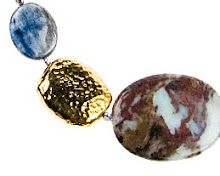
Gold vermeil (pronounced 'vermay') refers to metal that has been plated with a thin layer of gold. Usually the base metal is sterling silver, and if the item is to qualify as gold vermeil, it must have at least 10 karat layer of gold 1.5 micrometres thick. Stones and Findings carry gold vermeille chain and jewellery components with a plating of 22 to 24 karat gold.
Gold vermeil was originally produced in France in the mid-18th century through a process called fire gilding. However, a key component of the fire gilding process was mercury, and so much of it was needed to plate the base metal (about twice as much as gold, by weight), that it was an incredibly dangerous process, frequently resulting in blindness or other injuries. Unsurprisingly, fire gilding of this sort was eventually banned by the French government.
A century later in England, George and Henry Elkington were able to develop and patent a new way of plating metals known as electroplating. Electroplating is an electrochemical process that applies positive and negative charges to metals, causing them to associate favourably. The process is, thankfully, totally safe and mercury free. As a result, we have continued using the same process pioneered by the brothers Elkington up until the present day, with only minor modifications and refinements.

Modern electroplating deposits some 120 layers of gold onto the base metal, creating affordable, tarnish-resistant gold vermeil jewellery that can last for decades with proper care.
To look at various examples of brushed and shiny gold vermeille, click here.
For other examples of gold vermeille,click here.

No comments:
Post a Comment